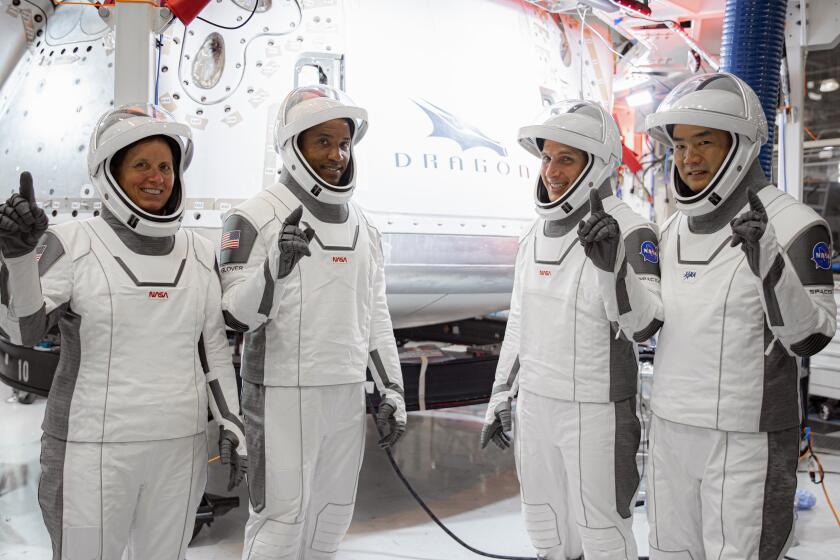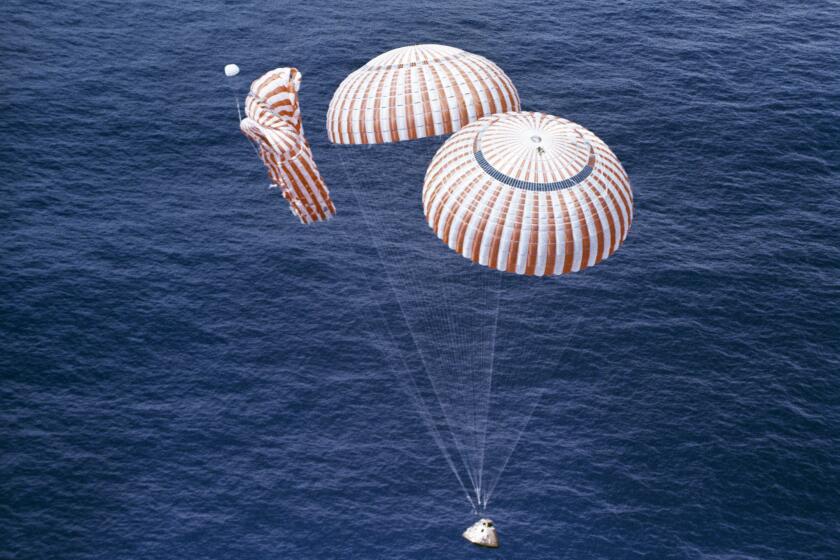SpaceX launches four astronauts to the International Space Station

- Share via
Six months after launching astronauts for the first time, SpaceX is sending another crew to the International Space Station.
The Elon Musk-led company launched three NASA astronauts and one astronaut from Japan’s space agency Sunday at 7:27 p.m. Eastern time from Florida’s Kennedy Space Center.
For the record:
3:29 p.m. Nov. 15, 2020A previous version of this story said SpaceX’s Crew Dragon capsule would dock with the space station 16 hours after launch. It is scheduled to dock 27 1/2 hours after launch.
About nine minutes after liftoff, the first stage of SpaceX’s Falcon 9 rocket landed on a floating droneship at sea. Then, about 12 minutes after launch, the Crew Dragon capsule properly separated from the second stage of the rocket en route to the space station.
“I’m pretty choked up ... thinking about the folks that have spent years of their lives getting ready for this mission,” Kathy Lueders, associate administrator of NASA’s human exploration and operations mission directorate told reporters after the launch. “Everybody is so fired up. But we’re not done yet.”
The crew capsule is set to dock at the space station Monday after a 27 1/2-hour flight.
NASA astronauts Michael Hopkins, Victor Glover and Shannon Walker and Japan Aerospace Exploration Agency astronaut Soichi Noguchi are set to stay aboard the space station for a six-month mission.
Sunday’s launch is expected to usher in new and additional commercial opportunities in low-Earth orbit. There are movies to be shot, beauty products to be promoted and tourists to be welcomed to the space station.
On Sunday, SpaceX will embark on the first of its regular missions to launch crew to the International Space Station. It’s expected to usher in more commercial opportunities in low-Earth orbit.
This is the first so-called operational flight for SpaceX’s Crew Dragon capsule. Last week, NASA certified the spacecraft for regular transport of astronauts to and from the space station.
The approval came after a crewed test flight this year saw NASA astronauts Bob Behnken and Doug Hurley launch to space, attach the craft to the space station and splash down safely in the Gulf of Mexico.
After reviewing data from the test flight, SpaceX made some changes to the capsule, including a new heat shield design intended to prevent the deeper-than-expected erosion that was seen in four small parts of the capsule’s bottom after the test flight.
SpaceX also improved part of the capsule’s barometric pressure sensor to give more accurate measurements to help determine when to deploy the spacecraft’s drogue parachutes, which help slow it for splashdown.
The Hawthorne company also replaced two engines on the Falcon 9 rocket that carried the Crew Dragon capsule to space. It had found that two tiny vent holes were clogged by masking lacquer, which could have caused engine damage when the engines fired up.
In the next 15 months, SpaceX plans to launch at least seven Dragon capsules to the space station for NASA missions — some carrying cargo and others crew.
SpaceX President Gwynne Shotwell called this “the beginning of a new era in human spaceflight.”
Even SpaceX and Boeing, which have accomplished great engineering feats, are still grappling with the tech.
More to Read
Inside the business of entertainment
The Wide Shot brings you news, analysis and insights on everything from streaming wars to production — and what it all means for the future.
You may occasionally receive promotional content from the Los Angeles Times.













